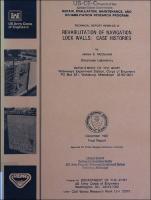Please use this identifier to cite or link to this item:
https://hdl.handle.net/11681/4422| Title: | Rehabilitation of navigation lock walls : case histories |
| Authors: | Repair, Evaluation, Maintenance, and Rehabilitation Research Program (U.S.) McDonald, J. E. (James E.) |
| Keywords: | Concrete Concrete removal Durability Navigation locks Rehabilitation Repair |
| Publisher: | Structures Laboratory (U.S.) Engineer Research and Development Center (U.S.) |
| Description: | Technical report Abstract: Approximately half of the Corps 269 navigation lock chambers were built prior to 1940. Consequently, the concrete in these structures does not contain intentionally entrained air and is therefore susceptible to deterioration by freezing air thawing. Since more than three-fourths of these older structures are located in the Corps North Central and Ohio River Divisions, areas of relatively severe climatic exposure, it is not surprising that the concrete in many of these structures exhibits significant freeze- thaw deterioration. Depending upon exposure conditions, depths of concrete deterioration can range from surface scaling to several feet. The general approach in lock wall rehabilitation has been to remove the deteriorated concrete and replace it with concrete or shotcrete. Explosive blasting has been used successfully at several Corps projects and appears to be the most cost-effective and expedient means for removing large quantities of concrete. Once the deteriorated concrete has been removed, conventional cast-in-place concrete has been used as the replacement material in lost lock wall rehabilitation projects. Other replacement systems that have been used or proposed include shotcrete, preplaced-aggregate concrete, and precast concrete style-in-place forms. In addition, several materials including latex-modified concrete, polymer mortars and grouts, conventional shotcrete, and latex-modified, fiber-reinforced shotcrete have been used as thin overlays on existing lock walls. Applications of the various rehabilitation systems and their performance to date are described in selected case histories. |
| Rights: | Approved for public release; distribution is unlimited. |
| URI: | http://hdl.handle.net/11681/4422 |
| Appears in Collections: | Technical Report |
Files in This Item:
| File | Description | Size | Format | |
|---|---|---|---|---|
| TR-REMR-CS-13.pdf | 51.79 MB | Adobe PDF |  View/Open |